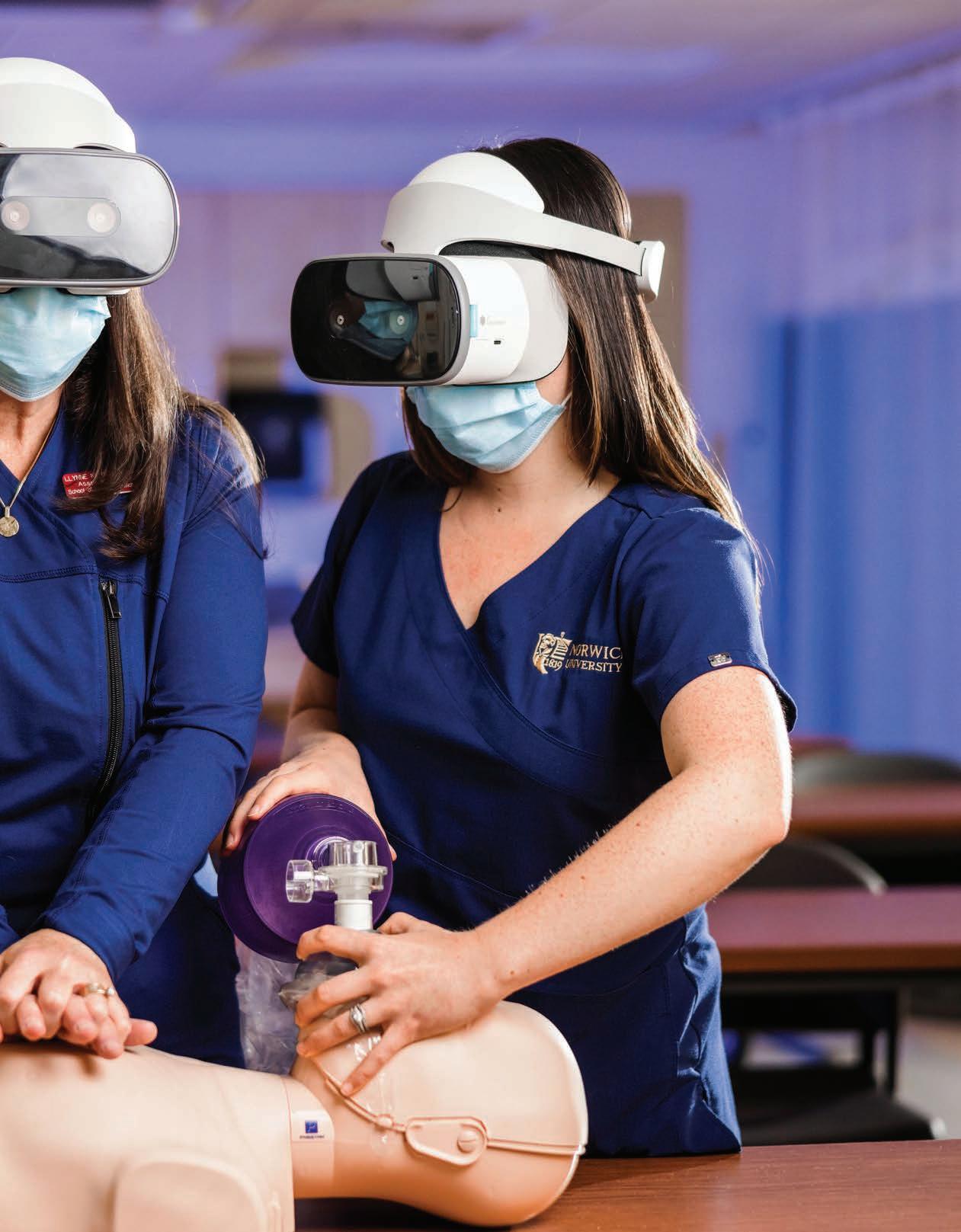
4 minute read
TECH IN FOCUS
Virtual Reality
The School of Nursing takes simulation labs to the cutting edge
Advertisement
Professor Llynne Kiernan, DNP, MSN, RN-BC teaches in the School of Nursing. Half of her course load is devoted to simulation labs—a figure that conveys their importance. Sim labs give nursing majors essential hands-on practice in both fundamental skills, such as taking blood pressure readings and inserting catheters, and more advanced critical care responses. Typically much of this training is done using specialized mannequins and prerecorded videos.
But virtual reality and other new technologies are now pushing the boundaries of the sim lab experience. Kiernan and colleague Sarah Manacek, MSN, RN are currently trialing Oculus Daydream VR headsets and simulation software from Oxford Medical Simulation. Soon, NU nursing majors will use VR headsets to interact with virtual patients in vivid, immersive hospital environments exquisitely rendered in 3-D. Enveloped by surround sound, they will encounter patients and medical staff that make eye contact and evince emotion.
Mannequins remain useful for practicing tactile skills but are surprisingly expensive. VR headsets and related software, meanwhile, are relatively cheap. VR’s other advantages include easy access, DIY practice, and a verisimilitude that can be emotional and stressful.
“Virtual reality is an active learning strategy that is grounded in the theory of situated cognition,” Kiernan says. “It allows students to apply and practice learned content in very realistic environments …. [One] benefit of this is the concept of deliberate practice, where students can practice and practice and practice until they feel competent.”
Manacek, a special surgery nurse who teaches medical surgical clinical rotations to NU nursing majors at the University of Vermont Medical Center, says VR offers extraordinary advances to the training experience.
“Patients are looking at you, freaked out. ‘I can’t breathe.’” Monitors beep. Alarms ring. “You feel like you’re really in the environment. It makes your heart race. It makes you feel anxious, which is important,” she says.
“People are looking at you for what to do, and you have to make those clinical decisions under that kind of pressure, which is very, very realistic,” she says. “Just like in the hospital.” n
VIRTUAL REALITY IRL
School of Nursing clinical instructor Sarah Manacek, MSN, RN (right) and Prof. Llynne Kiernan, DNP, MSN, RN-BC (left) are testing VR headsets and simulation laboratory software at the School of Nursing. Photo by Aram Boghosian
Hacking Diversity
Assistant Professor Lauren Provost, PhD, on DEI as a cybersecurity force multiplier
The country needs all the cybersecurity talent it can get. It also needs a more diverse, equitable, and inclusive cyber workforce, says Assistant Professor of Computer Science and Cybersecurity Lauren Provost, PhD. Afterall, when it comes to cyber, DEI is a superpower. It not only broadens the talent pool, it boosts competitiveness.
“The diversity of thought in problem-solving is to me the most critical piece,” says Provost, who serves on the NSA’s Science of Security Group. “If we don’t have a wide array of talent, we don’t have those different ideas. And one of those ideas just might be the solution that we’re looking for.”
That need extends to leadership. “We still have some of the current problems in industry, where there’s some lack of [diversity] in leadership. And when that happens, ideas from the non-leadership level can get lost and not necessarily valued.”
With that in mind, Provost is mentoring the next generation of cybersecurity and computer science majors at Norwich. Since joining the faculty of the School of Cybersecurity, Data Science, and Computing in the fall, she has taught courses in data structures and information assurance, launched a Women in Cyber student club, and worked with two undergraduate research interns (both women) on projects involving ethical hacking and the security of cloud container data storage.
Provost is also collaborating with the school’s DoD-funded Cyber Institute on outreach to K–12 schools to foster pathways for future careers in cybersecurity, something she has experience with as an educator and as policy advisor at the state and national levels.
As a first-generation college student herself, Provost knows that talent doesn’t discriminate by zip code, gender, or race. But talent does need support.
Provost arrived at college as a freshman not understanding financial aid or knowing what a major was. But talent and luck prevailed. She excelled at math and her local college was the University of Texas at Austin. “What I didn’t realize was, I was at a top 10 school at the time,” says Provost, who double majored in math and computer science. “That department was … very focused on supporting me and did everything they could to support my success.”
At Norwich, Provost looks to return the favor. “I see support from faculty to students every day at Norwich.” n
—SEAN MARKEY
WOMEN IN CYBER
Assistant Professor of Computer Science and Cybersecurity Lauren Provost, PhD, works with Xioana Mejias ’24, a cybersecurity major from Thornton, Colo. The pair collaborated last semester on a research project involving ethical hacking. Photo by Aram Boghosian










